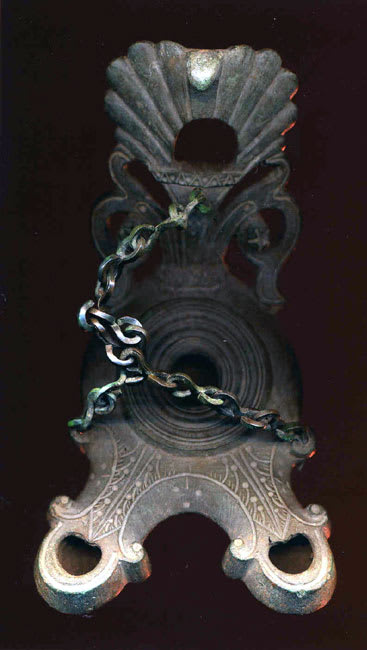Roman Bronze Hanging Double-Spouted Oil Lamp, 4th Century CE
Bronze
7.5
X.0076
While literally thousands of terracotta oil lamps survive from the Roman era, their bronze counterparts are remarkably rare. An average Roman citizen would have had a few fragile terracotta lamps...
While literally thousands of terracotta oil lamps survive from the Roman era, their bronze counterparts are remarkably rare. An average Roman citizen would have had a few fragile terracotta lamps scattered about the house to provide light in the hours of night. Bronze lamps were the domain of the wealthy elite whose villas would have been decorated with durable bronze lamps displayed on elegant stands. Bronze oil lamps were inherently more expensive due to the high cost of refining and casting metal. While luxury items in their own time, bronze lamps were often melted down for their metal value in times of war, only increasing their scarcity today.
This gorgeous bronze lamp, featuring a double-spouted burner to provide even more luminosity and a hanging chain, is especially rare. The bronze chain is remarkably intact, connected to the body by the side of each spout and along the shell-shaped handle. In antiquity, the body would have been filled with an oil, be it olive, fish, or castor, whatever was most plentiful in the region, and two wicks wound from fiber would have produced gentle flames at the spouts. Although a bit smelly and dirty, such a lamp could burn for to several hours in one filling. We can picture this lamp illuminating an ancient temple, the light flickering against the columns, throwing shadows onto the ground. However, it is just as likely that this lamp may have hung from a tree in the garden of a Roman villa while a wealthy merchant or officer hosted an evening party.
This gorgeous bronze lamp, featuring a double-spouted burner to provide even more luminosity and a hanging chain, is especially rare. The bronze chain is remarkably intact, connected to the body by the side of each spout and along the shell-shaped handle. In antiquity, the body would have been filled with an oil, be it olive, fish, or castor, whatever was most plentiful in the region, and two wicks wound from fiber would have produced gentle flames at the spouts. Although a bit smelly and dirty, such a lamp could burn for to several hours in one filling. We can picture this lamp illuminating an ancient temple, the light flickering against the columns, throwing shadows onto the ground. However, it is just as likely that this lamp may have hung from a tree in the garden of a Roman villa while a wealthy merchant or officer hosted an evening party.



